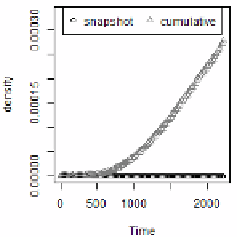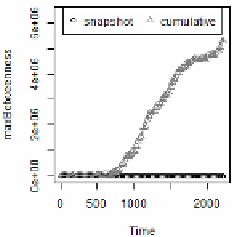Information Technology Reference
In-Depth Information
3.2 Sexual Network of Internet-Mediated Prostitution
Another dataset we investigated is Rocha's, Liljeros' and Holme's temporal,
bipartite sexual network dataset [22] constructed to analyze Internet-mediated
prostitution. The dataset describes a large, but very sparse network, containing
sexual contacts between 6,624 anonymous escorts and 10,106 sex buyers over
eight years.
“The community studied is a Brazilian, public online forum with
free registration that is financed by advertisements. In this community, male
members grade and categorize their sexual encounters with female escorts, both
using anonymous nicknames. The forum is oriented to heterosexual males.”
Results and Discussion. The density change of the cumulative network shows
an almost linear increasment to about
0
.
003. This finding is important because
(i) density has a direct influence on other statistics, thus this linear increasment
may also be observed on several depending values (like in the total number of
edges, proportional size of the maximal component, average betweenness, average
degree and the number of components also deacreasing in a linear tendency), and
(ii) this increase also indicates that the cumulative network is in the "initial"
state where the statistics have not yet reached their peek. The clustering of the
network is constant zero due to the bipartite nature of the dataset.
Other statistics shown on Figure 6 however show identical evolution over
time to the results we got for the different dynamic network models. Average
path length increases quickly and starts decreasing slowly after a high peek.
The maximal betweenness also shows the same initial increasing tendency we
described before.
∼
Fig. 6.
Simulation results by using the dataset of Rocha et al. with N=16,730 and
2,235 simulation time steps. Charts contain every
25
th measure points of the evolution
of density, maximum betweenness and average path length over time.
The degree distribution (depicted on Figure 7) also shows a familiar structure
we obtained for larger dynamic network simulations: the number of isolated
vertices is decreasing as a "spread out" pattern is emerging in the distribution.
An interesting aspect of the dataset is that it keeps the scale-free property for





